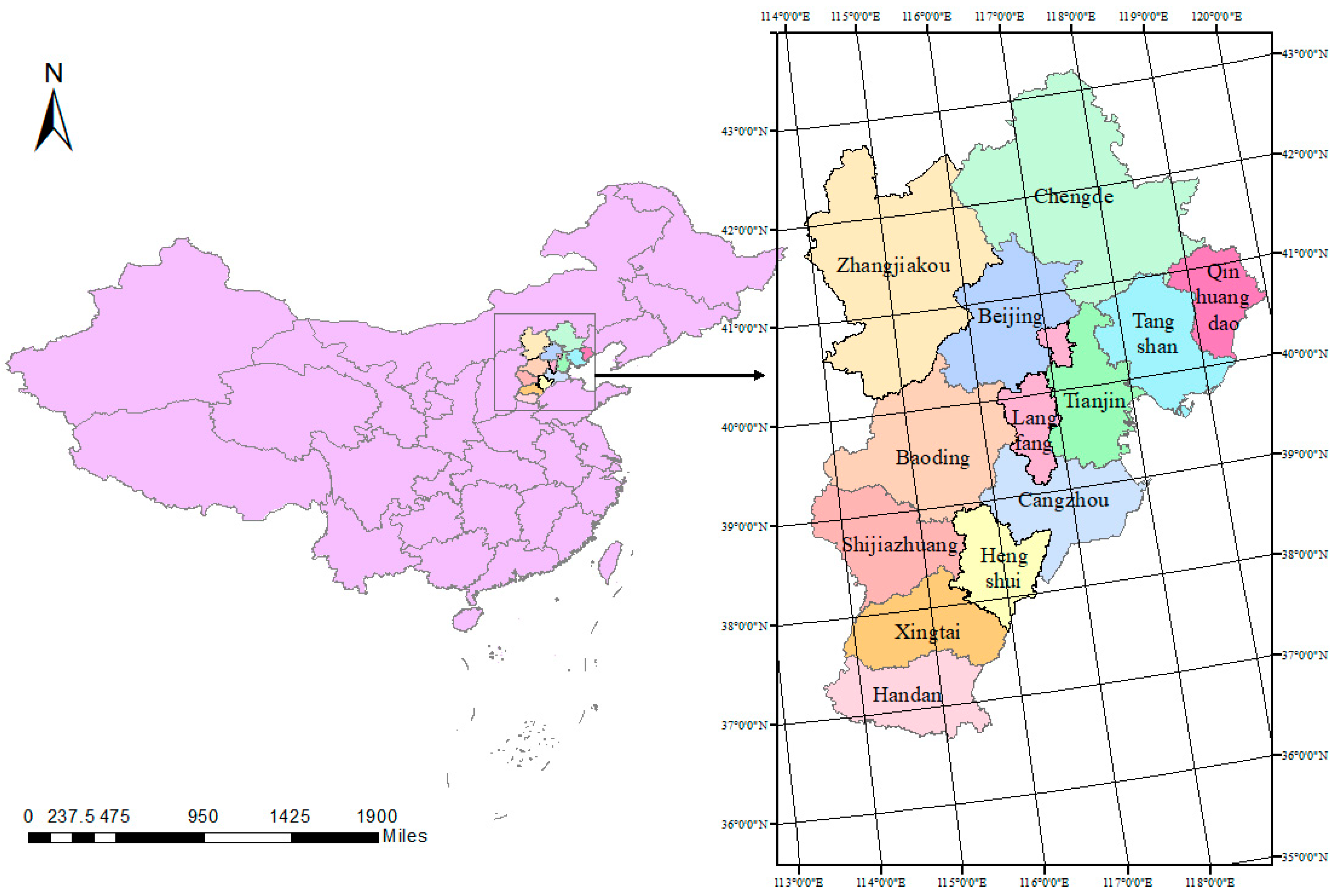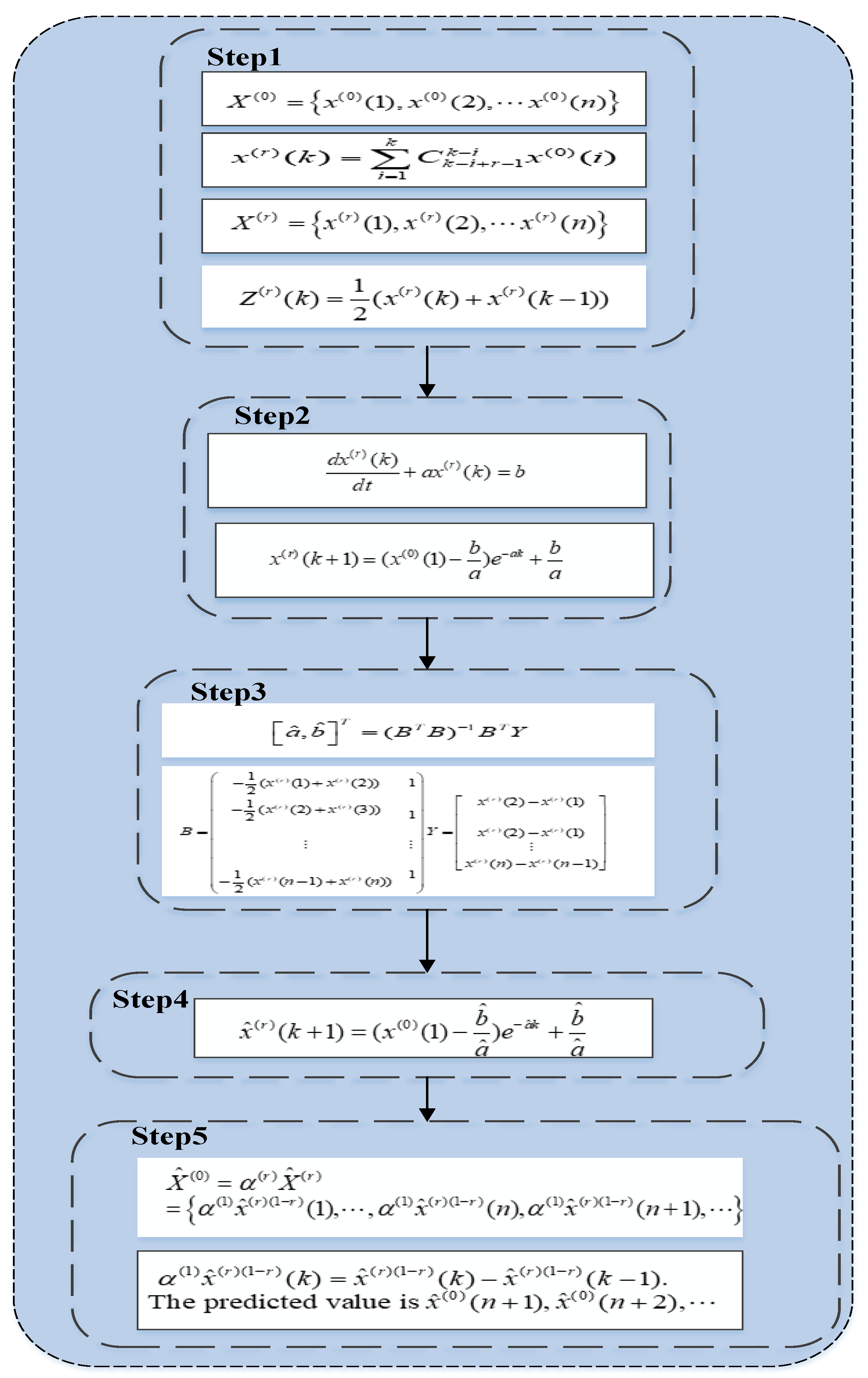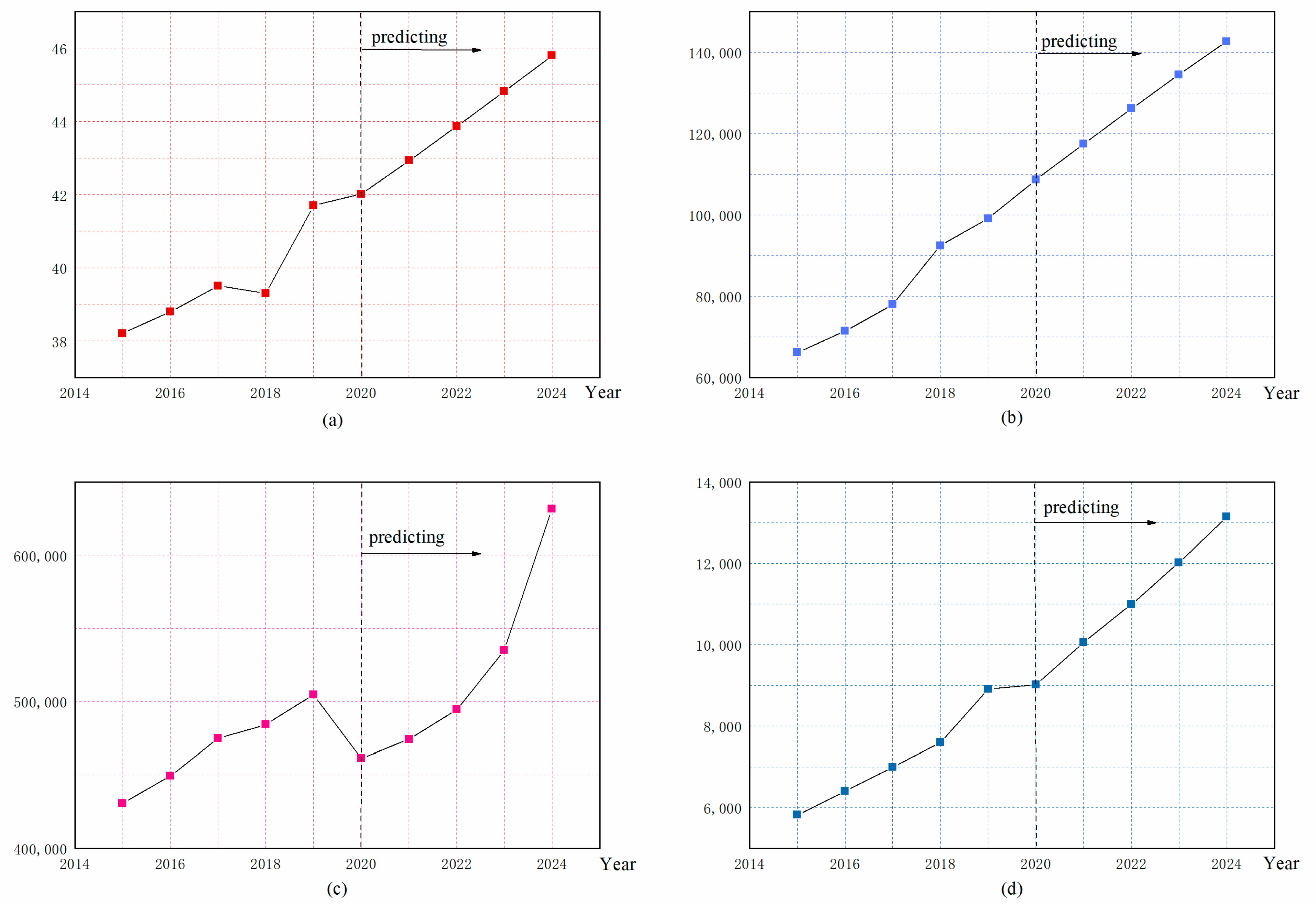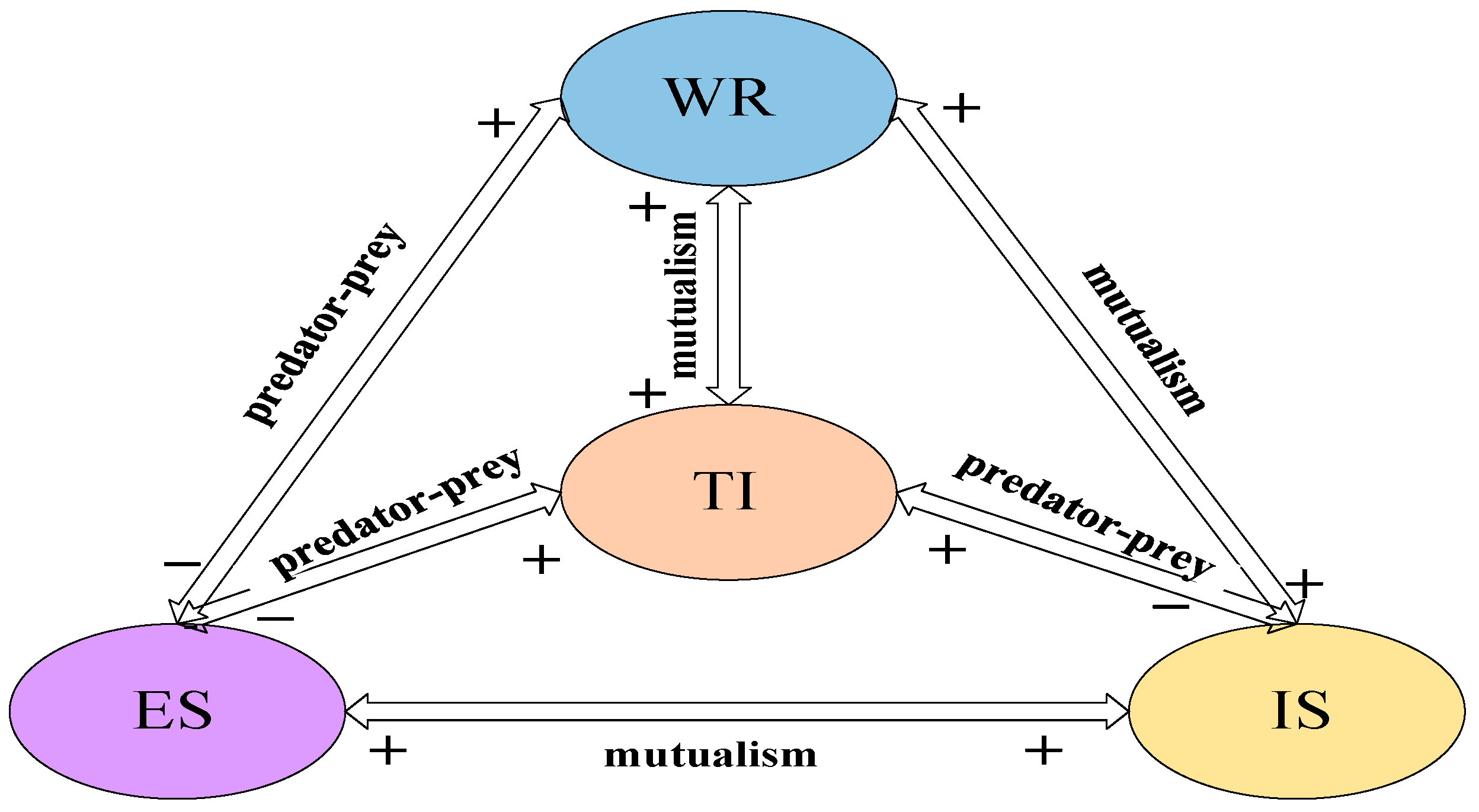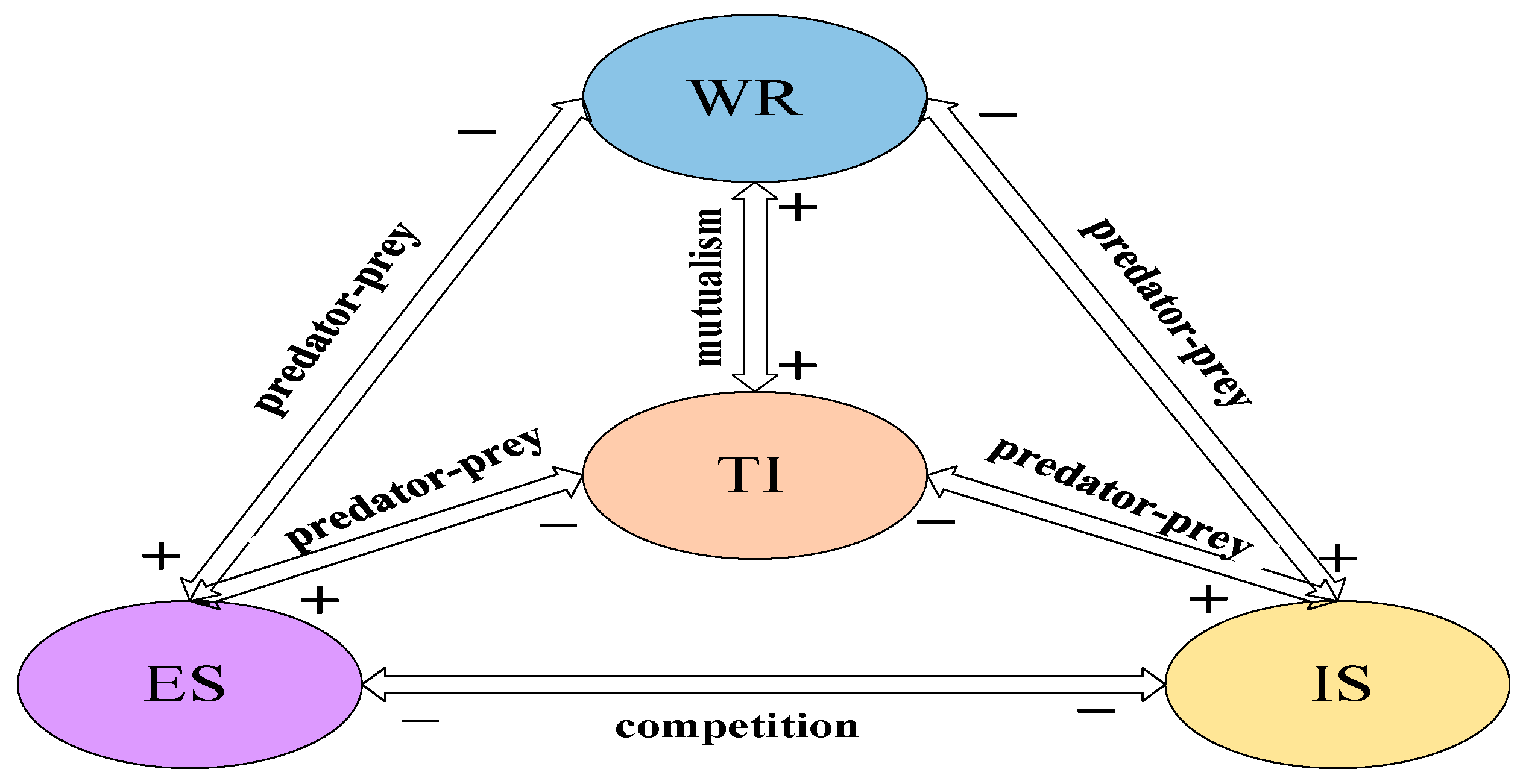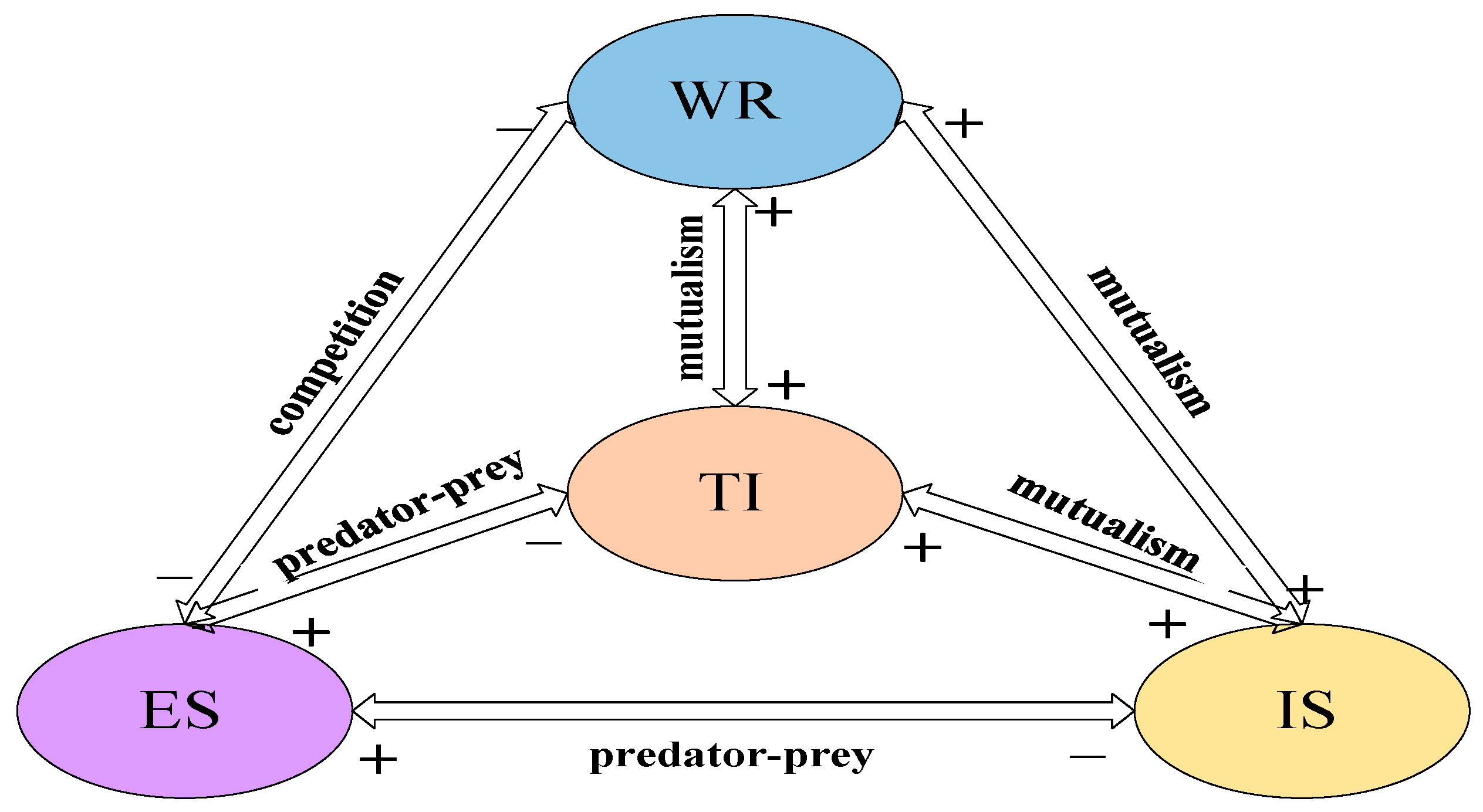4.2.1. Analysis on the Status Quo of Beijing-Tianjin-Hebei
(1) Beijing area
Figure 4 shows that there is a predator-predator relationship among Economic System, Industrial System and Technology Innovation System. This phenomenon shows that the current high-tech industry in Beijing still needs to be improved, and it has not attained a state of benign competition with other industries.
In
Table 3 that reflects the existence of a predator-predation relationship between the Water Resources System and Economy System. The Water Resources System hinders the development of the Economy System, but the Economy System provides a boost to the Water Resources System. At the same time, the influence coefficient of the Economy System on the Water Resources System is 0.01611328, and the influence coefficient of the Water Resources System on the Economy System is 0.00001788. This shows that the Economy System has a greater impact on the Water Resources System, and the development of the Economic System determines the development of the Water Resources System. In order to achieve healthy competition between the two systems, it is necessary to strictly control the reasonable use of water resources in the Water Resources System under the conditions of rapid economic development.
This shows that there is a mutualistic relationship between Water Resources System and Industrial System. However, it shows that Industrial System controls Water Resources System, and the increase in industrial output value will face an increase in Water Resources System. Under the requirements of high-quality and sustainable development, the total amount of water supply should be controlled within a reasonable range while increasing industrial added value.
From
Table 3, the degree of influence of Technology Innovation System on Water Resource System is 0.0439453125, and Water Resource System on Technology Innovation System is 0.0000953674, indicating that there is a competitive relationship between the two. According to the above data, Beijing should increase the investment in technological innovation, and the continuous progress of technological innovation will reduce the total water supply.
It shows that there is a mutualistic between the Economy System and the Industrial System. Based on data, it can be seen that as the total industrial output continues to increase, the economic system also increases.
There is a predator-predator relationship between the Economy System and Technology Innovation System. The impact coefficient of Economy System on Technology Innovation System is greater than the impact of Technology Innovation System on the Economy System, indicating that economic conditions determine the development of technological innovation. Economic foundation determines the ability to innovate. Therefore, to improve the level of local economy, but also pay attention to the development of innovation ability.
Predatory relationship exists between Industrial system and Technology Innovation system. The continuous innovation of science and technology will promote an increase in industrial output value. Thus, paying attention to technological progress, actively adjusting the industrial structure, and eliminating outdated production capacity. By improving industrial efficiency and developing high-tech industries, Beijing’s industrial development will be more in line with the needs of the people.
(2) Tianjin area
It can be seen from
Figure 5 that there is a predator-predator relationship among the Tianjin Water Resources System, Economy System and Industrial System. There is a mutual relationship between the Water Resources System and the Technology Innovation System. There is a competitive relationship between the Economy System and Industrial System systems. Economy System, Industrial System and Technology Innovation System have a predatory relationship.
Now analyze it based on the detailed data in
Table 4. It indicates the existence of a predation relationship between the system and the system. The Economy System hinders the development of the system, but the Water Resources System provides a boost to the Economy System. The influence coefficient of the Economy System on the Water Resources System is 0.02166748, and the influence coefficient of the Water Resources System on the Economy System is 0.00004959. This shows that the Economy System has a greater impact on the Water Resources System, and the development of the economic system determines the development of water resources.
Predation relationships exist between Water System and Industrial System. The predator-prey relationship means that the development of one system hinders the development of another system. Due to the Industrial System has a greater impact on the Water Resources System. The emergence of this phenomenon shows that the connection between the industrial added value of Tianjin and the water resources system is poor, and the water consumption has not been reasonably controlled under the premise of securing the steady growth of industrial output.
There is a mutual relationship between Water Resources System and Technology Innovation System. The degree of Technology Innovation System’s influence on Water Resources System is 0.02306366, and the degree of Water Resources System’s influence on Technology Innovation System is 0.00082397, reflecting that technological innovation has a greater influence on the total water supply. Although there is a mutually beneficial relationship between the two, they have not reached a competitive relationship. Only proper competitive relations can foster the high-quality development of various indicators.
Economy System and Industrial System are competing shows in
Figure 5. The current economic situation of Tianjin is closely associated with gross industrial output value. To improve the regional economy, it is necessary to grasp the value of industrial output value, but the influence degree between them and the relationship between them still need to be stable.
Predator-predator relationship between Economy System and Technology Innovation System. The effect coefficient of Economy System on Technology Innovation System is greater than the impact of Technology Innovation System on Economy System, indicating that economic conditions determine the development of technological innovation. Economic base determines innovation ability. Therefore, to improve the level of local economy, but also pay attention to the development of innovation ability.
Obviously, there is a predatory relationship between the Industrial System and the Technology Innovation System. However, industrial output has a greater impact on technological innovation, so technological progress must be taken seriously.
(3) Hebei area
Through Equation (34), one can find that the value in Industrial System is negative, and the value in Technology Innovation System is less than 1. This value of expresses the parameter of the system itself, and the value is generally greater than 1. However, the data in Hebei showed a negative value. This means that there are serious problems in the industrial system, which need to be improved.
In
Table 5,
, indicating that there is a competitive relationship between Water Resources System and Economy System. In addition, the influence degree of Economy System on Water Resources System is greater than the influence degree of Water Resources System on Economy System. The Economy System determines the degree of change in the Water Resources System. It can also be said that the level of consumption determines the degree of water consumption, but the growth of the economic system should not be based on sacrificing water resources. The goal wants to accomplish is to decrease the rational use of water resources while the economy grows steadily, so as to achieve a state of win-win cooperation.
From
Table 5,
, a mutualistic relationship is formed between Water Resources System and Industrial System.
, a mutualistic relationship is formed between Water Resources System and Technology Innovation System.
, there is a symbiotic relationship between Industrial System and Technology Innovation System. The relationship between Water Resources System, Industrial System and Technology Innovation System is symbiosis, which shows that the current general trend in Hebei is conducive to the development of Technology Innovation System.
In accordance with
Table 5, ,
show that the relationship between Economic System, Industrial System and Technology Innovation System in Hebei is predicated. Due to
, the influence of the Industrial System on the Economic System is greater than the influence of the Economic System on the Industrial System. Hebei Province is a province with a large proportion of the secondary industry in the Beijing-Tianjin-Hebei region. In recent years, it has been consistently optimizing and upgrading its industrial structure. The upgrading of industrial structure will have a great impact on the economy, but there is a predatory relationship between Economic System and Technology Innovation System. The continuous progress of science and technology requires strong support from the economy. However, in turn, the advancement of science and technology will enhance the manufacturing capacity of industrial enterprises or provide suggestions for the optimization and upgrading of the industrial structure in the province. Technology Innovation System and Economic System should be a state of symbiosis or benign competition, rather than a relationship of predation. Therefore, Hebei Province should pay attention to the relationship between systems, so that the various system levels within the province can form a situation of balanced competition.
4.2.2. Analysis of Equilibrium and Stability
The stability of the system is mainly analyzed according to the calculated values of
, and
.
Table 6,
Table 7 and
Table 8, respectively, show the stability calculation of Beijing, Tianjin and Hebei.
From
Table 6 that
in E15 is greater than 0, but
in E15 has a value not greater than 0.
are not all greater than 0 from E0 to E14, and the range of values fluctuates greatly. It is believed that the four systems of Beijing Water Resources System, Economic System, Industrial System, and Technology Innovation System have not attained a trend of consistent competition and coordinated growth since 2015.
By calculating the stability of Tianjin data, it is found that the value of
p,
q in the calculated data at point E15 in
Table 7 is less than 0. It shows that in Tianjin, Water Resources System, Economic System, Industrial System, and Technology Innovation System have not attained stable and coordinated development. However, the values of
at point E1, E2 are all greater than zero. It shows that the development of Water Resources System and Economic System in the region is consistently stable. The coordination between systems has not been achieved. It is still necessary to enhance the coordination capabilities between systems to mutually foster high-quality development.
In
Table 8, Hebei is similar to Beijing and Tianjin, and there are unstable phenomena. In this table, only the E2 data in which
is greater than 0. However, the data of
in E2 only has
greater than 0, and all other data is 0. It shows that the Economic System of Hebei Province has reached a trend of steady growth. However, Hebei lacks the ability to collaborate between systems.
4.2.3. Analysis of Forecast Data
(1) Beijing area
Through the above data results, it is found that the relationship between the predicted data and the calculated system will have a lot of changes with the current situation. This phenomenon further proves that the current problems in the Beijing area require the establishment of more effective methods to promote stable competition between systems.
From
Table 9 and
Table 10, find that the relationship between the Water Resources System and the Economic System in Beijing has changed from the previous predation to an incompatible relationship. This phenomenon shows that there is a big problem between the Water Resources System and the Economic System. Thus, a good coupling relationship must be maintained between water conservation and stable economic development. Water Resources System and Technology Innovation System has changed from the previous competition to the current predator relationship, indicating that the development of one system between the two in the future will cause obstacles to the development of the other system. Other systems have developed in the direction of healthy competition, or in symbiosis. However, they must continue to improve and become better at maintaining this good posture.
(2) Tianjin area
According to the relationship between the systems in
Table 11 and
Table 12, find that the relationship between the five systems has changed. The Water Resources System and Economic System have changed from the prior predator relationship to the current competitive relationship. Water Resources System and Technology Innovation System have changed from a symbiotic relationship to a predator relationship. Economic System and Industrial System have changed from the previous competitive relationship to the predator relationship. Economic System and Technology Innovation System have changed from the previous predation to the current competitive relationship. The relationship between Industrial System and Technology Innovation System has changed from the previous predation to the current symbiotic relationship.
The constant changes in the relationship between systems confirm the previous stable conclusion. This phenomenon emergence is mostly because each system has not found a more suitable development direction and situation. This needs to fundamentally find a way to improve, to find the direction of coordinated development of each system.
(3) Hebei area
From
Table 13 and
Table 14, comparing the previous data, find that the relationship between the five systems has changed. The Water Resources System and Economic System have changed from the previous competitive relationship to a predator relationship. Water Resources System and Industrial System have changed from mutualistic to predation. Water Resources System and Technology Innovation System have changed from symbiosis to competition. Economic System and Industrial System changed from predation to symbiosis. Economic System and Industrial System have changed from predation to a mutualistic relationship.
Half of the relationship between systems in Hebei Province has become symbiosis, which refers to the mutual existence of two systems. This state seems to be in a stable situation, but as resource policies continue to change, the relationship between systems will also change. If the symbiosis relationship has been maintained or tends to a mutualistic state, it will undoubtedly cause problems between systems and affect the development of Hebei Province.
